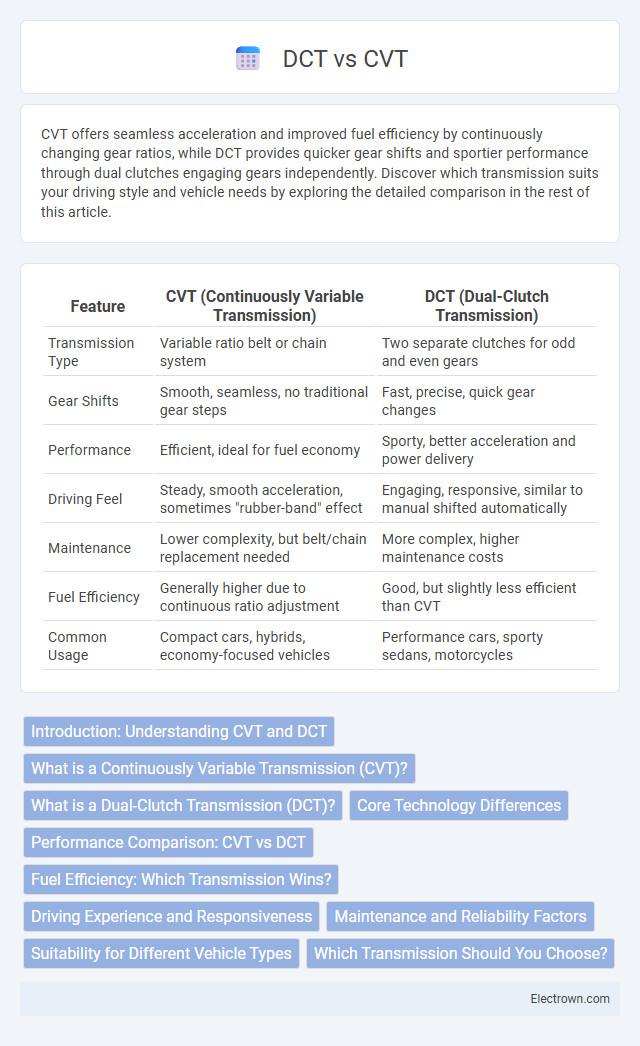CVT offers seamless acceleration and improved fuel efficiency by continuously changing gear ratios, while DCT provides quicker gear shifts and sportier performance through dual clutches engaging gears independently. Discover which transmission suits your driving style and vehicle needs by exploring the detailed comparison in the rest of this article.
Table of Comparison
| Feature | CVT (Continuously Variable Transmission) | DCT (Dual-Clutch Transmission) |
|---|---|---|
| Transmission Type | Variable ratio belt or chain system | Two separate clutches for odd and even gears |
| Gear Shifts | Smooth, seamless, no traditional gear steps | Fast, precise, quick gear changes |
| Performance | Efficient, ideal for fuel economy | Sporty, better acceleration and power delivery |
| Driving Feel | Steady, smooth acceleration, sometimes "rubber-band" effect | Engaging, responsive, similar to manual shifted automatically |
| Maintenance | Lower complexity, but belt/chain replacement needed | More complex, higher maintenance costs |
| Fuel Efficiency | Generally higher due to continuous ratio adjustment | Good, but slightly less efficient than CVT |
| Common Usage | Compact cars, hybrids, economy-focused vehicles | Performance cars, sporty sedans, motorcycles |
Introduction: Understanding CVT and DCT
Continuously Variable Transmission (CVT) utilizes a system of pulleys and a belt to provide seamless gear ratios for optimal fuel efficiency and smooth acceleration, adapting continuously to driving conditions. Dual-Clutch Transmission (DCT) employs two separate clutches for odd and even gear sets, enabling rapid gear changes and improved performance by pre-selecting the next gear. Both transmissions offer distinct advantages in driving dynamics, fuel economy, and vehicle responsiveness depending on the application.
What is a Continuously Variable Transmission (CVT)?
A Continuously Variable Transmission (CVT) is an automatic transmission system that seamlessly changes through a continuous range of gear ratios, unlike traditional transmissions with fixed gears. This allows the engine to operate at its most efficient RPM, improving fuel economy and providing smoother acceleration. Your driving experience benefits from the CVT's ability to deliver consistent power without the noticeable gear shifts found in Dual Clutch Transmissions (DCT).
What is a Dual-Clutch Transmission (DCT)?
A Dual-Clutch Transmission (DCT) is an advanced automated manual transmission that uses two separate clutches to manage odd and even gear sets, enabling lightning-fast gear shifts without interrupting power delivery. Unlike Continuously Variable Transmissions (CVTs) that provide seamless acceleration through a belt-driven system, DCTs deliver precise, step-based gear changes for improved performance and efficiency. Popular in high-performance vehicles, DCTs enhance driving dynamics by combining the smoothness of an automatic with the responsiveness of a manual gearbox.
Core Technology Differences
CVT (Continuously Variable Transmission) uses a system of belts and pulleys to provide an infinite range of gear ratios, optimizing fuel efficiency and smooth acceleration. DCT (Dual-Clutch Transmission) employs two separate clutches for odd and even gears, enabling faster and more precise gear shifts with minimal power loss. Your vehicle's performance and driving experience depend on these core technological differences, with CVT prioritizing seamless power delivery and DCT focusing on quick gear changes and sportier response.
Performance Comparison: CVT vs DCT
CVT (Continuously Variable Transmission) delivers seamless acceleration and fuel efficiency by providing an infinite range of gear ratios, ideal for smooth urban driving and better mileage. DCT (Dual-Clutch Transmission) offers faster gear shifts and superior responsiveness, enhancing performance in sporty driving scenarios and high acceleration demands. While CVT excels in comfort and fuel economy, DCT outperforms in terms of precise gear changes and driving dynamics.
Fuel Efficiency: Which Transmission Wins?
CVT (Continuously Variable Transmission) generally outperforms DCT (Dual-Clutch Transmission) in fuel efficiency due to its ability to maintain optimal engine speed by providing seamless gear ratio adjustments. CVTs reduce fuel consumption by minimizing energy loss during acceleration and cruising, making them ideal for urban driving conditions. While DCTs offer quicker gear shifts and sportier performance, their fixed gear sets often result in slightly higher fuel consumption compared to the smooth, adaptive nature of CVTs.
Driving Experience and Responsiveness
Continuously Variable Transmissions (CVTs) provide smooth acceleration by eliminating gear shifts, enhancing fuel efficiency but sometimes causing a less engaging driving feel due to a "rubber band" sensation. Dual-Clutch Transmissions (DCTs) deliver quicker, more precise gear changes, offering a sportier and more responsive driving experience preferred in performance vehicles. While CVTs prioritize seamless transitions for comfort, DCTs excel in responsiveness and driver engagement during dynamic driving conditions.
Maintenance and Reliability Factors
CVT transmissions require regular inspection of the belt or chain and fluid changes to maintain optimal performance, while DCT systems often demand more frequent clutch replacements due to wear under heavy use. Reliability-wise, CVTs are praised for smooth operation and fuel efficiency but may face durability issues under high torque, whereas DCTs offer quicker gear shifts and robustness but can experience complex maintenance challenges. Understanding these factors helps you balance long-term maintenance costs and reliability when choosing between CVT and DCT transmissions.
Suitability for Different Vehicle Types
Continuously Variable Transmissions (CVTs) excel in fuel efficiency and smooth acceleration, making them ideal for compact cars, hybrids, and urban vehicles prioritizing comfort and economy. Dual-Clutch Transmissions (DCTs) offer rapid gear shifts and sporty performance, suiting high-performance cars and larger vehicles where driving dynamics and power delivery are crucial. Understanding your vehicle type and driving priorities helps determine whether CVT or DCT technology best aligns with your needs for efficiency or performance.
Which Transmission Should You Choose?
Choosing between a CVT (Continuously Variable Transmission) and a DCT (Dual-Clutch Transmission) depends on your driving style and vehicle priorities. A CVT offers smooth, fuel-efficient acceleration ideal for city driving and comfort-focused rides, while a DCT provides faster, more precise gear shifts suited for sporty performance and spirited driving. Your choice should align with whether you prioritize seamless efficiency or dynamic driving responsiveness.
CVT vs DCT Infographic

 electrown.com
electrown.com